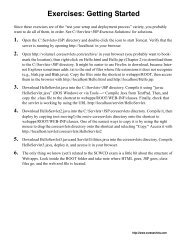Integrating Servlets and JSP: The Model View Controller - Java ...
Integrating Servlets and JSP: The Model View Controller - Java ...
Integrating Servlets and JSP: The Model View Controller - Java ...
Create successful ePaper yourself
Turn your PDF publications into a flip-book with our unique Google optimized e-Paper software.
Possibilities for H<strong>and</strong>ling aSingle Request8• Servlet only. Works well when:– Output is a binary type. E.g.: an image– <strong>The</strong>re is no output. E.g.: you are doing forwarding or redirection asin Search Engine example.– Format/layout of page is highly variable. E.g.: portal.• <strong>JSP</strong> only. Works well when:– Output is mostly character data. E.g.: HTML– Format/layout mostly fixed.• Combination (MVC architecture). Needed when:– A single request will result in multiple substantially differentlookingresults.– You have a large development team with different team membersdoing the Web development <strong>and</strong> the business logic.– You perform complicated data processing, but have a relativelyfixed layout.MVC Misconceptions9• An elaborate framework is necessary– Frameworks are often useful• JSF (<strong>Java</strong>Server Faces)– You should strongly consider JSF 2.0 for medium/large projects!• Struts– <strong>The</strong>y are not required!• Implementing MVC with the builtin RequestDispatcherworks very well for most simple <strong>and</strong> even moderatelycomplex applications• MVC totally changes your system design– You can use MVC for individual requests– Think of it as the MVC approach, not theMVC architecture• Also called the <strong>Model</strong> 2 approach
MVC-Based Alternative to<strong>Servlets</strong> <strong>and</strong> <strong>JSP</strong>: JSF 2• <strong>Servlets</strong> <strong>and</strong> <strong>JSP</strong>– Well-established st<strong>and</strong>ard– Used by google.com, ebay.com, walmart.com, <strong>and</strong> thous<strong>and</strong>sof other popular sites– Relatively low level by today’s st<strong>and</strong>ards– Covered in this tutorial• JSF (<strong>Java</strong>Server Faces) Version 2– Now an official part of <strong>Java</strong> EE 6• But runs in any recent <strong>Java</strong>-enabled server, including Tomcat 6+– Higher-level features: integrated Ajax support, fieldvalidation, page templating, rich third-party componentlibraries, etc. Designed around the MVC approach.– Not yet as widely used, but recommended for many or mostnew projects– Covered at http://www.coreservlets.com/JSF-Tutorial/jsf2/10© 2012 Marty HallBeans11Customized <strong>Java</strong> EE Training: http://courses.coreservlets.com/<strong>Java</strong>, JSF 2, PrimeFaces, <strong>Servlets</strong>, <strong>JSP</strong>, Ajax, jQuery, Spring, Hibernate, RESTful Web Services, Hadoop, Android.Developed <strong>and</strong> taught by well-known author <strong>and</strong> developer. At public venues or onsite at your location.
Review: Beans• <strong>Java</strong> classes that follow certain conventions– (Must have a zero-argument (empty) constructor)• You can satisfy this requirement either by explicitlydefining such a constructor or by omitting all constructors• In this version of MVC, it is not required to have zero argconstructor if you only instantiate from <strong>Java</strong> code– Should have no public instance variables (fields)• I hope you already follow this practice <strong>and</strong> use accessormethods instead of allowing direct access to fields– Persistent values should be accessed through methodscalled getXxx <strong>and</strong> setXxx• If class has method getTitle that returns a String, classis said to have a String property named title• Boolean properties can use isXxx instead of getXxx12Bean Properties: ExamplesMethod Names Property Name Example <strong>JSP</strong> UsagegetFirstNamesetFirstNamefirstName${customer.firstName}isExecutivesetExecutive(boolean property)getExecutivesetExecutive(boolean property)getZIPsetZIPexecutiveexecutiveZIP${customer.executive}${customer.executive}${address.ZIP}Note 1: property name does not exist anywhere in your code. It is just a shortcut for the method name.Note 2: property name is derived only from method name. Instance variable name is irrelevant.13
Example: StringBeanpackage coreservlets;public class StringBean {private String message = "No message specified";public String getMessage() {return(message);}}public void setMessage(String message) {this.message = message;}• Beans installed in normal <strong>Java</strong> directory– Eclipse: src/folderMatchingPackage– Deployed: …/WEB-INF/classes/folderMatchingPackage• Beans (<strong>and</strong> utility classes) must always be in packages!14© 2012 Marty HallBasic MVC Design15Customized <strong>Java</strong> EE Training: http://courses.coreservlets.com/<strong>Java</strong>, JSF 2, PrimeFaces, <strong>Servlets</strong>, <strong>JSP</strong>, Ajax, jQuery, Spring, Hibernate, RESTful Web Services, Hadoop, Android.Developed <strong>and</strong> taught by well-known author <strong>and</strong> developer. At public venues or onsite at your location.
MVC Flow of ControlHTML or <strong>JSP</strong><strong>Java</strong> Code(Business Logic)Formsubmit form(Form action matches URL of servlet,which is either from @WebServlet orfrom url-pattern in web.xml)Argumentsbased onform dataResults(beans)Servlet(Store beans in request,session, or application scope)<strong>JSP</strong> 1<strong>JSP</strong> 2<strong>JSP</strong> 3(Extract data from beans<strong>and</strong> put in output)16MVC Flow of Control(Annotated)HTML or <strong>JSP</strong>Customer currentCustomer =lookupService.findCustomer(customerId);<strong>Java</strong> Code(Business Logic)FormSend customer IDsubmit form(Form action matchesURL of servlet.)PasscustomerID to Argumentslookup based onserviceform dataResults(beans)ServletGet backcurrentcustomerthat hasthe ID(Store beans in request,session, or application scope)request.setAttribute("customer",currentCustomer);<strong>JSP</strong> 1<strong>JSP</strong> 2<strong>JSP</strong> 3(Extract data from beans<strong>and</strong> put in output)${customer.firstName}${customer.balance}17Parts in blue are examples for a banking application.
18Implementing MVC withRequestDispatcher1. Define beans to represent result data– Ordinary <strong>Java</strong> classes with at least one getBlah method2. Use a servlet to h<strong>and</strong>le requests– Servlet reads request parameters, checks for missing<strong>and</strong> malformed data, calls business logic, etc.3. Obtain bean instances– <strong>The</strong> servlet invokes business logic (application-specificcode) or data-access code to obtain the results.4. Store the bean in the request, session, orservlet context– <strong>The</strong> servlet calls setAttribute on the request, session, orservlet context objects to store a reference to the beansthat represent the results of the request.19Implementing MVC withRequestDispatcher (Continued)5. Forward the request to a <strong>JSP</strong> page.– <strong>The</strong> servlet determines which <strong>JSP</strong> page is appropriate tothe situation <strong>and</strong> uses the forward method ofRequestDispatcher to transfer control to that page.6. Extract the data from the beans.– <strong>JSP</strong> 1.2 (Old!)• <strong>The</strong> <strong>JSP</strong> page accesses beans with jsp:useBean <strong>and</strong> ascope matching the location of step 4. <strong>The</strong> page thenuses jsp:getProperty to output the bean properties.– <strong>JSP</strong> 2.0 (Preferred!)• <strong>The</strong> <strong>JSP</strong> page uses ${nameFromServlet.property} tooutput bean properties– Either way, <strong>JSP</strong> page does not create or modify bean; itmerely extracts <strong>and</strong> displays data that servlet created.
Request Forwarding Example20public void doGet(HttpServletRequest request,HttpServletResponse response)throws ServletException, IOException {... // Do business logic <strong>and</strong> get dataString operation = request.getParameter("operation");if (operation == null) {operation = "unknown";}String address;if (operation.equals("order")) {address = "/WEB-INF/Order.jsp";} else if (operation.equals("cancel")) {address = "/WEB-INF/Cancel.jsp";} else {address = "/WEB-INF/UnknownOperation.jsp";}RequestDispatcher dispatcher =request.getRequestDispatcher(address);dispatcher.forward(request, response);}jsp:useBean in MVC vs.in St<strong>and</strong>alone <strong>JSP</strong> Pages• <strong>The</strong> <strong>JSP</strong> page should not create the objects– <strong>The</strong> servlet, not the <strong>JSP</strong> page, should create all the dataobjects. So, to guarantee that the <strong>JSP</strong> page will not createobjects, you should useinstead of• <strong>The</strong> <strong>JSP</strong> page should not modify the objects– So, you should use jsp:getProperty but notjsp:setProperty.21
© 2012 Marty HallScopes:request, session, <strong>and</strong>application (ServletContext)22Customized <strong>Java</strong> EE Training: http://courses.coreservlets.com/<strong>Java</strong>, JSF 2, PrimeFaces, <strong>Servlets</strong>, <strong>JSP</strong>, Ajax, jQuery, Spring, Hibernate, RESTful Web Services, Hadoop, Android.Developed <strong>and</strong> taught by well-known author <strong>and</strong> developer. At public venues or onsite at your location.Scopes23• Idea– A “scope” is a place that the bean is stored. This placecontrols where <strong>and</strong> for how long the bean is visible.• Three choices– Request• Data stored in the request is visible to the servlet <strong>and</strong> tothe page the servlet forwards to. Data cannot be seen byother users or on other pages. Most common scope.– Session• Data stored in the request is visible to the servlet <strong>and</strong> tothe page the servlet forwards to. Data can be seen onother pages or later in time if it is the same user. Datacannot be seen by other users. Moderately common.– Application (Servlet Context)• Data stored in the servlet context is visible to all users <strong>and</strong>all pages in the application. Rarely used.
Request-Based Data Sharing• ServletSomeBean value = LookupService.findResult(...);request.setAttribute("key", value);RequestDispatcher dispatcher =request.getRequestDispatcher("/WEB-INF/SomePage.jsp");dispatcher.forward(request, response);24• <strong>JSP</strong> 2.0${key.someProperty}• <strong>JSP</strong> 1.2 (Old!)Name chosen by the servlet.Name of accessor method, minus theword “get”, with next letter changedto lower case.Request-Based Data Sharing:Simplified Example• ServletCustomer myCustomer =Lookup.findCust(request.getParameter("customerID"));request.setAttribute("customer", myCustomer);RequestDispatcher dispatcher =request.getRequestDispatcher("/WEB-INF/SomePage.jsp");dispatcher.forward(request, response);• <strong>JSP</strong> 2.0${customer.firstName}Assume that the findCust methodh<strong>and</strong>les missing/malformed data.Note: the Customer class musthave a method called “getFirstName”.• <strong>JSP</strong> 1.225
Session-Based Data Sharing• ServletSomeBean value = LookupService.findResult(...);HttpSession session = request.getSession();session.setAttribute("key", value);RequestDispatcher dispatcher =request.getRequestDispatcher("/WEB-INF/SomePage.jsp");dispatcher.forward(request, response);26• <strong>JSP</strong> 2.0${key.someProperty}• <strong>JSP</strong> 1.2Session-Based Data Sharing:Variation• Redirect to page instead of forwarding to it– Use response.sendRedirect instead of RequestDispatcher.forward• Distinctions: with sendRedirect:– User sees <strong>JSP</strong> URL (user sees only servlet URL withRequestDispatcher.forward)– Two round trips to client (only one with forward)• Advantage of sendRedirect– User can visit <strong>JSP</strong> page separately• User can bookmark <strong>JSP</strong> page• Disadvantages of sendRedirect– Two round trips to server is more expensive– Since user can visit <strong>JSP</strong> page without going through servlet first,bean data might not be available• So, <strong>JSP</strong> page needs code to detect this situation27
ServletContext-Based DataSharing (Rare)28• <strong>Servlets</strong>ynchronized(this) {SomeBean value = SomeLookup.findResult(...);getServletContext().setAttribute("key", value);RequestDispatcher dispatcher =request.getRequestDispatcher("/WEB-INF/SomePage.jsp");dispatcher.forward(request, response);}• <strong>JSP</strong> 2.0${key.someProperty}• <strong>JSP</strong> 1.2Relative URLs in <strong>JSP</strong> Pages• Issue:– Forwarding with a request dispatcher is transparent to theclient. Original URL (i.e., the form action URL) is onlyURL browser knows about.• Why does this matter?– What will browser do with tags like the following?…29– Browser treats addresses as relative to servlet URL
© 2012 Marty HallExample:Bank Balance Lookup30Customized <strong>Java</strong> EE Training: http://courses.coreservlets.com/<strong>Java</strong>, JSF 2, PrimeFaces, <strong>Servlets</strong>, <strong>JSP</strong>, Ajax, jQuery, Spring, Hibernate, RESTful Web Services, Hadoop, Android.Developed <strong>and</strong> taught by well-known author <strong>and</strong> developer. At public venues or onsite at your location.Applying MVC:Bank Account Balances• Bean– BankCustomer• Business Logic– BankCustomerLookup• Servlet that populates bean <strong>and</strong> forwards toappropriate <strong>JSP</strong> page– Reads customer ID, calls BankCustomerLookup’sdata-access code to obtain BankCustomer– Uses current balance to decide on appropriate result page• <strong>JSP</strong> pages to display results– Negative balance: warning page– Regular balance: st<strong>and</strong>ard page– High balance: page with advertisements added– Unknown customer ID: error page31
Bank Account Balances:Servlet Code32@WebServlet("/show-balance")public class ShowBalance extends HttpServlet {public void doGet(HttpServletRequest request,HttpServletResponse response)throws ServletException, IOException {String customerId = request.getParameter("customerId");CustomerLookupService service = new CustomerSimpleMap();Customer customer = service.findCustomer(customerId);request.setAttribute("customer", customer);String address;if (customer == null) {request.setAttribute("badId", customerId);address = "/WEB-INF/results/unknown-customer.jsp";} else if (customer.getBalance() < 0) {address = "/WEB-INF/results/negative-balance.jsp";} … /* normal-balance <strong>and</strong> high-balance cases*/ …}RequestDispatcher dispatcher =request.getRequestDispatcher(address);dispatcher.forward(request, response);Bank Account Balances:Beanpublic class Customer {private final String id, firstName, lastName;private final double balance;public Customer(String id,String firstName,String lastName,double balance) {this.id = id;this.firstName = firstName;this.lastName = lastName;this.balance = balance;}Since the constructor is called from <strong>Java</strong> only(never from <strong>JSP</strong>), the requirement for a zero-argconstructor is eliminated. Also, since bean stateis set only with constructor, rather than withjsp:setProperty, we can eliminate settermethods <strong>and</strong> make the class immutable.// getId, getFirstName, getLastName, getBalance. No setters.33}public double getBalanceNoSign() {return(Math.abs(balance));}
Bank Account Balances:Business Logic Interfacepublic interface CustomerLookupService {public Customer findCustomer(String id);}34Bank Account Balances:Business Logic Implementationpublic class CustomerSimpleMapimplements CustomerLookupService {private Map customers;public CustomerSimpleMap() {// Populate Map with some sample customers}35}public Customer findCustomer(String id) {if (id!=null) {return(customers.get(id.toLowerCase()));} else {return(null);}}…
Bank Account Balances:Input Form…Bank Account BalanceCustomer ID (id001, id002, id003):…<strong>The</strong> address http://host/appName/show-balance comes from the @WebServlet annotation in this case,but could also be set in older servers using the url-pattern entry in web.xml.36Bank Account Balances:Negative Balance (<strong>JSP</strong> 2.0)37…We Know Where You Live!Watch out, ${customer.firstName},we know where you live. Pay us the $${customer.balanceNoSign}you owe us before it is too late!
38Bank Account Balances:Negative Balance (<strong>JSP</strong> 1.2)…We Know Where You Live!Watch out,,we know where you live. Pay us the$you owe us before it is too late!Bank Account Balances:Normal Balance…Your BalanceFirst name: ${customer.firstName}Last name: ${customer.lastName}ID: ${customer.id}Balance: $${customer.balance}39
Bank Account Balances:High Balance40……It is an honor to serve you,${customer.firstName} ${customer.lastName}!Since you are one of our most valued customers, we would liketo offer you the opportunity to spend a mere fraction of your$${customer.balance} on a boat worthy of your status.Please visit our boat store for more information.Bank Account Balances:Unknown Customer…Unknown CustomerNo customer found with id "${badId}"Please try again.41
Bank Account Balances:Results42© 2012 Marty HallComparing DataSharing Approaches43Customized <strong>Java</strong> EE Training: http://courses.coreservlets.com/<strong>Java</strong>, JSF 2, PrimeFaces, <strong>Servlets</strong>, <strong>JSP</strong>, Ajax, jQuery, Spring, Hibernate, RESTful Web Services, Hadoop, Android.Developed <strong>and</strong> taught by well-known author <strong>and</strong> developer. At public venues or onsite at your location.
Summary44• Request scope– A new bean instance is made on every HTTP request.– <strong>The</strong> most common scope.• Session scope– A bean instance could be reused if the request is from thesame user in the same browser session. Useful fortracking user-specific data.• See session tracking lecture for details• Remember to make bean Serializable• Application (ServletContext) scope– Once created, the same bean instance is used for allrequests <strong>and</strong> all users.• Must synchronize. Very rare.Comparing Data-SharingApproaches: Request• Goal– Display a r<strong>and</strong>om number to the user• Type of sharing– Each request should result in a new number, so requestbasedsharing is appropriate.45
Request-Based Sharing: Beanpublic class NumberBean {private final double num;public NumberBean(double number) {this.num = number;}}public double getNumber() {return(num);}<strong>The</strong> property name in <strong>JSP</strong> will be “number”. <strong>The</strong> property name is derived from the method name, not fromthe instance variable name. Also note the lack of a corresponding setter.46Request-Based Sharing: Servlet@WebServlet("/r<strong>and</strong>om-number")public class R<strong>and</strong>omNumberServlet extends HttpServlet {@Overridepublic void doGet(HttpServletRequest request,HttpServletResponse response)throws ServletException, IOException {NumberBean bean =RanUtils.r<strong>and</strong>omNum(request.getParameter("range"));request.setAttribute("r<strong>and</strong>omNum", bean);String address = "/WEB-INF/results/r<strong>and</strong>om-num.jsp";RequestDispatcher dispatcher =request.getRequestDispatcher(address);dispatcher.forward(request, response);}}47
Request-Based Sharing:Business Logicpublic class RanUtils {public static NumberBean r<strong>and</strong>omNum(String rangeString) {double range;try {range = Double.parseDouble(rangeString);} catch(Exception e) {range = 10.0;}return(new NumberBean(Math.r<strong>and</strong>om() * range));}}private RanUtils() {} // Uninstantiable class48Request-Based Sharing:Input Form...R<strong>and</strong>om NumberRange: ...49
Request-Based Sharing:Results PageR<strong>and</strong>om NumberR<strong>and</strong>om Number: ${r<strong>and</strong>omNum.number}50Request-Based Sharing:Results51
Comparing Data-SharingApproaches: Session• Goal– Display users’ first <strong>and</strong> last names.– If the users fail to tell us their name, we want to usewhatever name they gave us previously.– If the users do not explicitly specify a name <strong>and</strong> noprevious name is found, a warning should be displayed.• Type of sharing– Data is stored for each client, so session-based sharing isappropriate.52Session-Based Sharing: Beanpublic class NameBean implements Serializable {private String firstName = "Missing first name";private String lastName = "Missing last name";public String getFirstName() {return(firstName);}public void setFirstName(String firstName) {if (!isMissing(firstName)) {this.firstName = firstName;}}... // getLastName, setLastName53}private boolean isMissing(String value) {return((value == null) || (value.trim().equals("")));}
Session-Based Sharing:Results56Comparing Data-SharingApproaches: ServletContext• Goal– Display a prime number of a specified length.– If the user fails to tell us the desired length, we want touse whatever prime number we most recently computedfor any user.• Type of sharing– Data is shared among multiple clients, so applicationbasedsharing is appropriate.57
ServletContext-Based Sharing:Beanpackage coreservlets;import java.math.BigInteger;public class PrimeBean {private BigInteger prime;public PrimeBean(String lengthString) {int length = 150;try {length = Integer.parseInt(lengthString);} catch(NumberFormatException nfe) {}this.prime = Primes.nextPrime(Primes.r<strong>and</strong>om(length));}58}public BigInteger getPrime() {return(prime);}…ServletContext-Based Sharing:Servlet59@WebServlet("/find-prime")public class PrimeServlet extends HttpServlet {public void doGet(HttpServletRequest request,HttpServletResponse response)throws ServletException, IOException {String length = request.getParameter("primeLength");ServletContext context = getServletContext();synchronized(this) {if ((context.getAttribute("primeBean") == null) ||(!isMissing(length))) {PrimeBean primeBean = new PrimeBean(length);context.setAttribute("primeBean", primeBean);}String address = "/WEB-INF/mvc-sharing/ShowPrime.jsp";RequestDispatcher dispatcher =request.getRequestDispatcher(address);dispatcher.forward(request, response);}}… // Definition of isMissing: null or empty string}
ServletContext-Based Sharing:Results PageA Prime NumberA Prime Number${primeBean.prime}60ServletContext-Based Sharing:Results61
© 2012 Marty HallForwarding <strong>and</strong>Including62Customized <strong>Java</strong> EE Training: http://courses.coreservlets.com/<strong>Java</strong>, JSF 2, PrimeFaces, <strong>Servlets</strong>, <strong>JSP</strong>, Ajax, jQuery, Spring, Hibernate, RESTful Web Services, Hadoop, Android.Developed <strong>and</strong> taught by well-known author <strong>and</strong> developer. At public venues or onsite at your location.Forwarding from <strong>JSP</strong> Pages 0.5) {destination = "/examples/page1.jsp";} else {destination = "/examples/page2.jsp";}%>• Legal, but bad idea– Business <strong>and</strong> control logic belongs in servlets– Keep <strong>JSP</strong> focused on presentation63
Including Pages Instead ofForwarding to <strong>The</strong>m• With the forward method– New page generates all of the output– Original page or other pages cannot generate any output• With the include method– Output can be generated by multiple pages– Original page can generate output before <strong>and</strong> after theincluded page– Original servlet does not see the output of the includedpage (for this, see later topic on servlet/<strong>JSP</strong> filters)– Applications• Portal-like applications (see first example)• Setting content type for output (see second example)64Using RequestDispatcher.include:portals65response.setContentType("text/html");String firstTable, secondTable, thirdTable;if (someCondition) {firstTable = "/WEB-INF/results/sports-scores.jsp";secondTable = "/WEB-INF/results/stock-prices.jsp";thirdTable = "/WEB-INF/results/weather.jsp";} else if (...) { ... }RequestDispatcher dispatcher =request.getRequestDispatcher("/WEB-INF/results/header.jsp");dispatcher.include(request, response);dispatcher =request.getRequestDispatcher(firstTable);dispatcher.include(request, response);dispatcher =request.getRequestDispatcher(secondTable);dispatcher.include(request, response);dispatcher =request.getRequestDispatcher(thirdTable);dispatcher.include(request, response);dispatcher =request.getRequestDispatcher("/WEB-INF/results/footer.jsp");dispatcher.include(request, response);
Using RequestDispatcher.include:Setting Content-Type of Output66// From Ajax examplepublic void doGet(...) ... {...if ("xml".equals(format)) {response.setContentType("text/xml");outputPage = "/WEB-INF/results/cities-xml.jsp";} else if ("json".equals(format)) {response.setContentType("application/json");outputPage = "/WEB-INF/results/cities-json.jsp";} else {response.setContentType("text/plain");outputPage = "/WEB-INF/results/cities-string.jsp";}RequestDispatcher dispatcher =request.getRequestDispatcher(outputPage);dispatcher.include(request, response);}cities-xml.jsp67${cities[0].name}${cities[0].shortTime}${cities[0].population}...• Notes– Because I use .jsp (not .jspx) <strong>and</strong> classic <strong>JSP</strong> syntax, thedefault content-type is text/html– I could use here,but it is more convenient to do it in calling servlet <strong>and</strong>keep this page simple <strong>and</strong> focused on presentation
© 2012 Marty HallWrap-UpCustomized <strong>Java</strong> EE Training: http://courses.coreservlets.com/<strong>Java</strong>, JSF 2, PrimeFaces, <strong>Servlets</strong>, <strong>JSP</strong>, Ajax, jQuery, Spring, Hibernate, RESTful Web Services, Hadoop, Android.Developed <strong>and</strong> taught by well-known author <strong>and</strong> developer. At public venues or onsite at your location.Summary69• Use MVC (<strong>Model</strong> 2) approach when:– One submission will result in more than one basic look– Several pages have substantial common processing– Your application is moderately complex• Approach– A servlet answers the original request– Servlet calls business logic <strong>and</strong> stores results in beans• Beans stored in HttpServletRequest, HttpSession, orServletContext– Servlet invokes <strong>JSP</strong> page via RequestDispatcher.forward– <strong>JSP</strong> page reads data from beans• Most modern servers: ${beanName.propertyName}• <strong>JSP</strong> 1.2 servers: jsp:useBean with appropriate scope(request, session, or application) plus jsp:getProperty
© 2012 Marty HallQuestions?JSF 2, PrimeFaces, <strong>Java</strong> 7, Ajax, jQuery, Hadoop, RESTful Web Services, Android, Spring, Hibernate, <strong>Servlets</strong>, <strong>JSP</strong>, GWT, <strong>and</strong> other <strong>Java</strong> EE training70Customized <strong>Java</strong> EE Training: http://courses.coreservlets.com/<strong>Java</strong>, JSF 2, PrimeFaces, <strong>Servlets</strong>, <strong>JSP</strong>, Ajax, jQuery, Spring, Hibernate, RESTful Web Services, Hadoop, Android.Developed <strong>and</strong> taught by well-known author <strong>and</strong> developer. At public venues or onsite at your location.
















